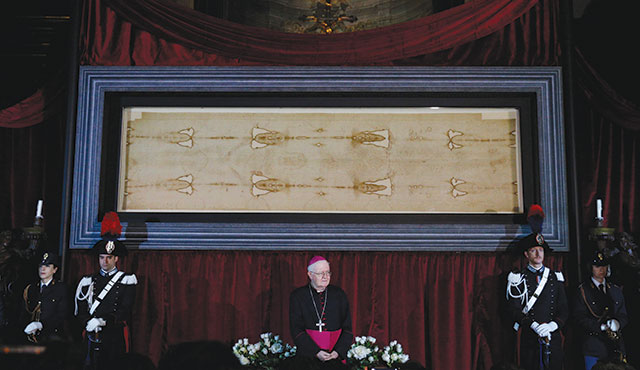What more is there to add about the Shroud of Turin? The linen cloth with the faint image of the crucified Jesus in the position of burial is perhaps more popular today than at any other time.
But the Shroud unlocks for us another world.
When the Shroud emerged in recorded history (mid-late 1300s), the Paschal Mystery and the tomb of the Holy Sepulcher dominated medieval thought and prayer. Since much of our modern outlook on the faith was shaped by the reforms of the Council of Trent (1545-1563), our journey into this earlier world requires a fresh perspective.
The medieval mind hungered for Christ in the Holy Eucharist. Transubstantiation was defined at the Fourth Lateran Council in 1215, and the Feast of Corpus Christi was proclaimed by Pope Urban IV, with help from St. Thomas Aquinas, in 1264. Urban IV was born in Troyes, 10 miles from where the Shroud emerged the following century.
Art and liturgy were in perfect harmony at this time. For the many who could not read or write, powerful visualizations about the sacrifice of the Son of God supplemented the Eucharist.
In the mid-1300s, when the Pope resided in nearby Avignon, the Holy Roman Empire bordered France. This region was and still is known as Alsace, where the Rhine flows past picturesque villages and towns. Holy Graves monuments (Heiligen Gräber in German) blossomed here in the 14th century. These physical structures were either in a side chapel, a crypt evoking the Jerusalem tomb, or were portable, like a coffin. Effigies of Christ in these monuments, called gisants, bore striking similarities to the image of the man on the Shroud. Sculptures of the mourning women (Three Marys) look down at the reposed body of Christ.
Some of these effigies, which still exist, contain a receptacle in Christ’s chest, such as the Holy Grave at the Church of St. Nicholas in Haugenau, or the Chapel of St. Catherine in the Strasbourg cathedral. Here the consecrated Host was placed during the Holy Thursday liturgy and remained until the distribution of Communion on Good Friday. This action forcefully connected the crucified body in the tomb with the Eucharistic Christ.
These Holy Grave monuments served as the foundation for a later devotional movement, Entombment sculptures. While the Holy Graves were specific to the Rhineland, the entombments spread out across Christendom. Typically, Joseph of Arimathea and Nicodemus shroud the crucified Christ while St. John, Mary Magdalene, the Blessed Mother, and other characters, sometimes even angels, huddle around Christ’s reposed body, hands folded one over the other as in the Shroud.
Joseph of Arimathea, Nicodemus, and the shroud featured prominently in Burgundian entombments. The folds of the entombment shroud at Hotel Dieu Notre Dame des Fontenilles in the Burgundy town Tonnerre resemble the folds seen in the Turin Shroud. Burgundy was the home of the “Shroud Families” who possessed the Shroud in the 14th and 15th centuries.
Predating both the Holy Graves and entombments were the immensely popular liturgical dramas. St. Æthelwold’s tenth-century chronicle (Regularis Concordia) is one of the earliest examples we have of a liturgical Easter drama, forerunners to the modern Passion plays. Æthelwold’s stage directions for the Visitatio Sepulchri (Visit to the Tomb) by the Three Marys on Easter morning, when the angel asks them, “Whom are you looking for?” instructs the women to dramatically expose the gravecloth found in Christ’s empty tomb before setting the linens on the altar. Later depictions of clergy displaying the Shroud of Turin mimics this gesture exactly.
Gradually, lifesize Christ figures became more graphic in depicting Passion sufferings, such as at the Church of Saint Dominique in Vieux-Thann. Some of these had moveable arms, from the position of crucifixion to burial in the tomb. Instruments used in the Passion (Arma Christi) were also incorporated in crucifixion art.
Mystics such as the stigmatic Elizabeth of Spalbeek, Gertrude van der Oosten, and Margaret of Cortona annually acted out the Passion in harrowing detail. The Man of Sorrows (Imago Pietatis), showing the upper body of the crucified Christ, developed at this time. The origin of this icon was directly linked to the consecration of the bread and wine.
Of course, Veronica’s veil was perhaps the quintessential Passion devotion in the west second only to the Holy Sepulcher.
The Orthodox Church commemorates Christ’s burial with the epitaphios, a richly embroidered icon. It is moved from the altar on Passion Friday and placed in a symbolic tomb. It is returned to the altar before the Paschal Matins. The epitaphios image of Christ is nearly identical to the frontal image on the Shroud.
Today, while the debate about the Shroud’s origins continues, we can now look upon this linen cloth with new eyes, as our ancestors in the faith might have, and contemplate the Paschal Mystery with renewed gratitude.



